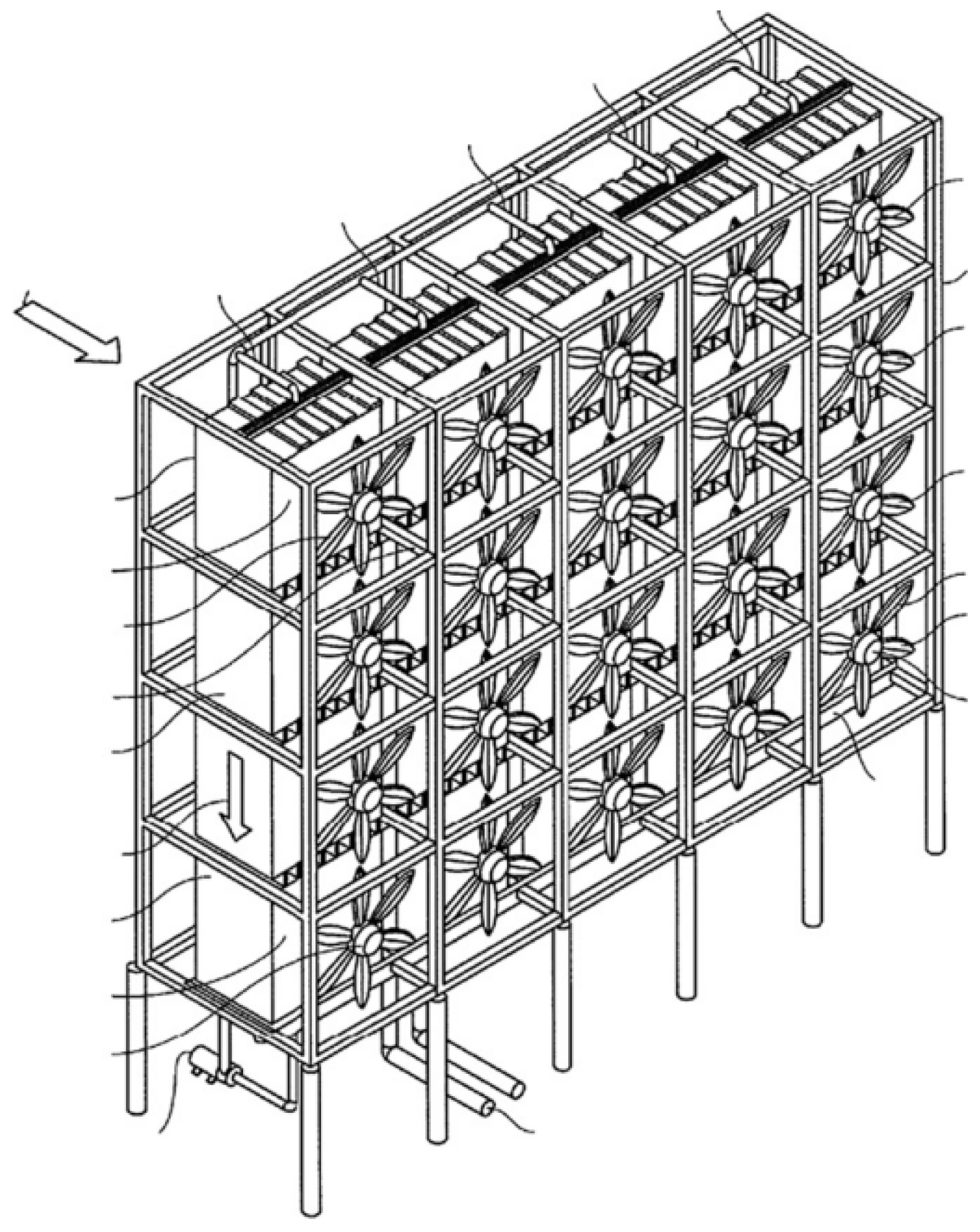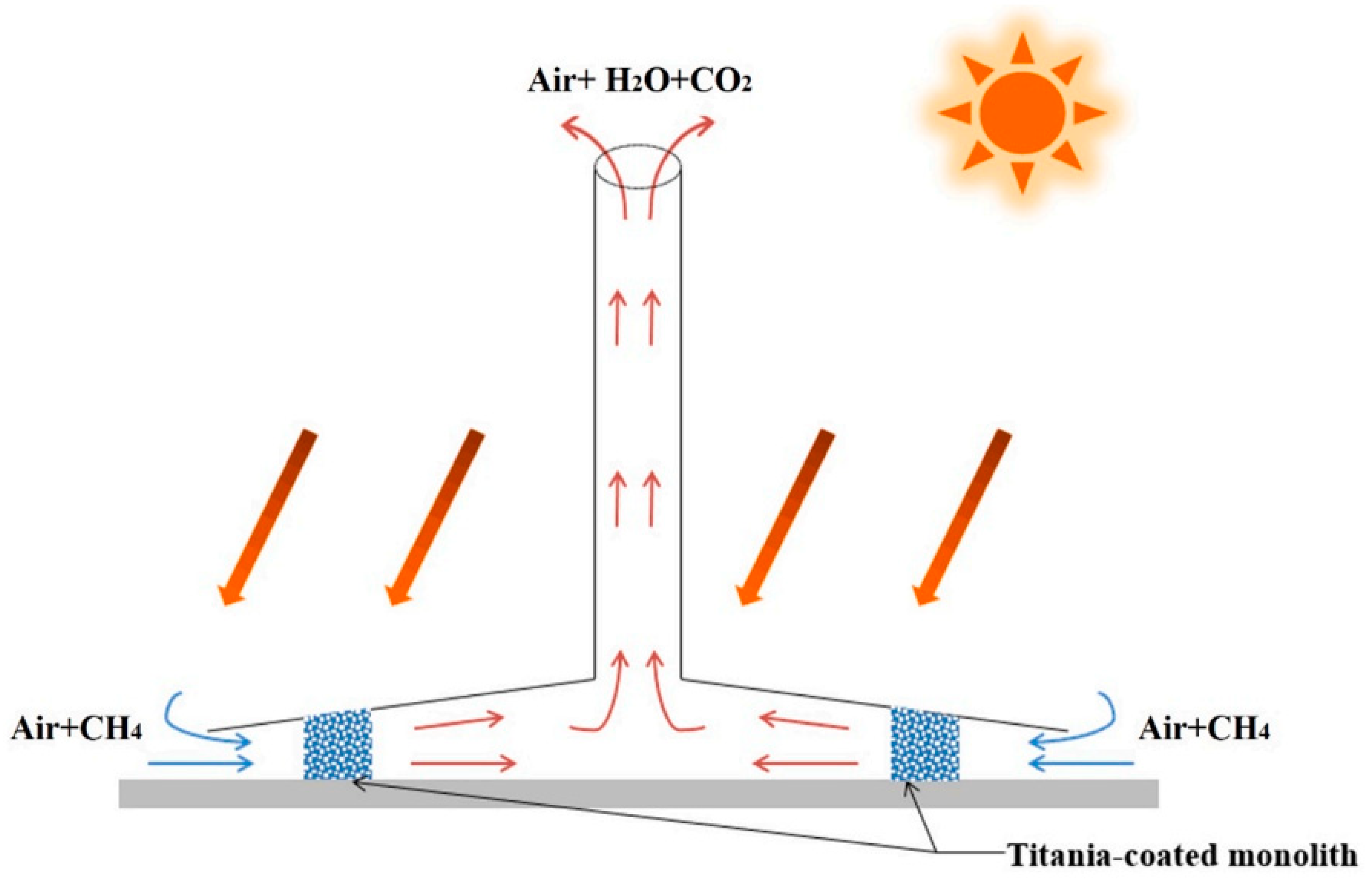Methods of Large-Scale Capture and Removal of Atmospheric Greenhouse Gases
1. Introduction
2. Greenhouse Gases in the Atmosphere
2.1. Capture and Removal of CO2
2.2. Capture and Removal of CH4
3. Conclusions
- The disadvantages of the current methods for quick, large-scale CO2 removal from the atmosphere can include significant energy consumption, high investment, and high maintenance costs. Transformative technologies are needed in this field.
- The removal of atmospheric CH4 is a worthwhile goal, but because this gas is so rarefied, and removing it remains a challenge.
- Although the study of SCPP-PCRs is still in its early stages, it appears to be a promising technology that can not only decrease CO2 emissions from thermal power plants but also the diminish greenhouse gases that are in the air.
Funding
Conflicts of Interest
References
- Houghton, J. Global warming. Rep. Prog. Phys. 2005, 68, 1343–1403. [Google Scholar] [CrossRef]
- Koç, İ. Changes that may occur in temperature, rain, and climate types due to global climate change: The example of Düzce. Turk. J. Agric. -Food Sci. Technol. 2021, 9, 1545–1554. [Google Scholar] [CrossRef]
- Allan, R.P.; Hawkins, E.; Bellouin, N.; Collins, B. IPCC, 2021: Summary for Policymakers; Cambridge University Press: Cambridge, UK, 2021. [Google Scholar]
- Shiklomanov, I.A.; Rodda, J.C. World Water Resources at the Beginning of the Twenty-First Century; Cambridge University Press: Cambridge, UK, 2004. [Google Scholar]
- Tebaldi, C.; Ranasinghe, R.; Vousdoukas, M.; Rasmussen, D.J.; Vega-Westhoff, B.; Kirezci, E.; Kopp, R.E.; Sriver, R.; Mentaschi, L. Extreme sea levels at different global warming levels. Nat. Clim. Chang. 2021, 11, 746–751. [Google Scholar] [CrossRef]
- Zandalinas, S.I.; Fritschi, F.B.; Mittler, R. Global Warming, Climate Change, and Environmental Pollution: Recipe for a Multifactorial Stress Combination Disaster. Trends Plant Sci. 2021, 26, 588–599. [Google Scholar] [CrossRef]
- Vigueras-Zúñiga, M.O.; Ramírez-Ruíz, C.A.; Herrera-May, A.L.; Tejeda-del-Cueto, M.E. Numerical and Experimental Analysis of the Effect of a Swirler with a High Swirl Number in a Biogas Combustor. Energies 2021, 14, 2768. [Google Scholar] [CrossRef]
- Bohringer, C. The Kyoto Protocol: A Review and Perspectives. Oxf. Rev. Econ. Policy 2003, 19, 451–466. [Google Scholar] [CrossRef]
- Al-Ghussain, L. Global warming: Review on driving forces and mitigation. Environ. Prog. Sustain. Energy 2019, 38, 13–21. [Google Scholar] [CrossRef]
- Mousavi Motlagh, S.F.; Sohani, A.; Djavad Saghafi, M.; Sayyaadi, H.; Nastasi, B. Acquiring the Foremost Window Allocation Strategy to Achieve the Best Trade-Off among Energy, Environmental, and Comfort Criteria in a Building. Energies 2021, 14, 3962. [Google Scholar] [CrossRef]
- Kuylenstierna, J.C.; Michalopoulou, E.; Malley, C. Global Methane Assessment: Benefits and Costs of Mitigating Methane Emissions. Stockholm Environment Institute. 2021. Available online: https://policycommons.net/artifacts/1528411/global-methane-assessment/2218096/ (accessed on 1 July 2022).
- Romanak, K.; Fridahl, M.; Dixon, T. Attitudes on Carbon Capture and Storage (CCS) as a Mitigation Technology within the UNFCCC. Energies 2021, 14, 629. [Google Scholar] [CrossRef]
- Sharifian, R.; Wagterveld, R.; Digdaya, I.; Xiang, C.; Vermaas, D. Electrochemical carbon dioxide capture to close the carbon cycle. Energy Environ. Sci. 2021, 14, 781–814. [Google Scholar] [CrossRef]
- Ochedi, F.O.; Yu, J.; Yu, H.; Liu, Y.; Hussain, A. Carbon dioxide capture using liquid absorption methods: A review. Environ. Chem. Lett. 2021, 19, 77–109. [Google Scholar] [CrossRef]
- Lin, J.-B.; Nguyen, T.T.; Vaidhyanathan, R.; Burner, J.; Taylor, J.M.; Durekova, H.; Akhtar, F.; Mah, R.K.; Ghaffari-Nik, O.; Marx, S. A scalable metal-organic framework as a durable physisorbent for carbon dioxide capture. Science 2021, 374, 1464–1469. [Google Scholar] [CrossRef] [PubMed]
- Abd, A.A.; Othman, M.R.; Kim, J. A review on application of activated carbons for carbon dioxide capture: Present performance, preparation, and surface modification for further improvement. Environ. Sci. Pollut. Res. Int. 2021, 28, 43329–43364. [Google Scholar] [CrossRef] [PubMed]
- Rubin, E.S.; Davison, J.E.; Herzog, H.J. The cost of CO2 capture and storage. Int. J. Greenh. Gas Control 2015, 40, 378–400. [Google Scholar] [CrossRef]
- Mantripragada, H.C.; Zhai, H.; Rubin, E.S. Boundary Dam or Petra Nova–Which is a better model for CCS energy supply? Int. J. Greenh. Gas Control 2019, 82, 59–68. [Google Scholar] [CrossRef]
- Reiner, D.M. Learning through a portfolio of carbon capture and storage demonstration projects. Nat. Energy 2016, 1, 15011. [Google Scholar] [CrossRef]
- Muratori, M.; Bauer, N.; Rose, S.K.; Wise, M.; Daioglou, V.; Cui, Y.; Kato, E.; Gidden, M.; Strefler, J.; Fujimori, S. EMF-33 insights on bioenergy with carbon capture and storage (BECCS). Clim. Chang. 2020, 163, 1621–1637. [Google Scholar] [CrossRef]
- Muri, H. The role of large—Scale BECCS in the pursuit of the 1.5 C target: An Earth system model perspective. Environ. Res. Lett. 2018, 13, 044010. [Google Scholar] [CrossRef]
- Heck, V.; Gerten, D.; Lucht, W.; Popp, A. Author Correction: Biomass-based negative emissions difficult to reconcile with planetary boundaries. Nat. Clim. Chang. 2018, 8, 345. [Google Scholar] [CrossRef]
- Santori, G.; Charalambous, C.; Ferrari, M.-C.; Brandani, S. Adsorption artificial tree for atmospheric carbon dioxide capture, purification and compression. Energy 2018, 162, 1158–1168. [Google Scholar] [CrossRef] [Green Version]
- House, K.Z.; Baclig, A.C.; Ranjan, M.; van Nierop, E.A.; Wilcox, J.; Herzog, H.J. Economic and energetic analysis of capturing CO2 from ambient air. Proc. Natl. Acad. Sci. USA 2011, 108, 20428–20433. [Google Scholar] [CrossRef] [PubMed]
- Keith, D.W.; Holmes, G.; St. Angelo, D.; Heidel, K. A Process for Capturing CO2 from the Atmosphere. Joule 2018, 2, 1573–1594. [Google Scholar] [CrossRef]
- de_Richter, R.K.; Ming, T.; Caillol, S. Fighting global warming by photocatalytic reduction of CO2 using giant photocatalytic reactors. Renew. Sustain. Energy Rev. 2013, 19, 82–106. [Google Scholar] [CrossRef]
- Matthews, H.D.; Caldeira, K. Stabilizing climate requires near-zero emissions. Geophys. Res. Lett. 2008, 35, 1–5. [Google Scholar] [CrossRef]
- Vichi, M.; Navarra, A.; Fogli, P. Adjustment of the natural ocean carbon cycle to negative emission rates. Clim. Chang. 2013, 118, 105–118. [Google Scholar] [CrossRef]
- Blok, K.; Hare, W.; Hohne, N.; Kainuma, M.; Kejun, J.; Lee, D.S.; Rogelj, J.; Shukla, A.; Arent, D.; Bogner, J. Bridging the Emissions Gap: A UNEP Synthesis Report. The United Nations Environment Programme (UNEP). 2011. Available online: https://wedocs.unep.org/handle/20.500.11822/7996 (accessed on 1 July 2022).
- Kretschmer, K.; Biastoch, A.; Rüpke, L.; Burwicz, E. Modeling the fate of methane hydrates under global warming. Glob. Biogeochem. Cycles 2015, 29, 610–625. [Google Scholar] [CrossRef]
- Brenneis, R.J.; Johnson, E.P.; Shi, W.; Plata, D.L. Atmospheric-and Low-Level Methane Abatement via an Earth-Abundant Catalyst. ACS Environ. Au 2021, 2, 223–231. [Google Scholar] [CrossRef]
- de Richter, R.; Ming, T.Z.; Davies, P.; Liu, W.; Caillol, S. Removal of non-CO2 greenhouse gases by large-scale atmospheric solar photocatalysis. Prog. Energy Combust. 2017, 60, 68–96. [Google Scholar] [CrossRef]
- Ming, T.; Gui, H.; Shi, T.; Xiong, H.; Wu, Y.; Shao, Y.; Li, W.; Lu, X.; de Richter, R. Solar chimney power plant integrated with a photocatalytic reactor to remove atmospheric methane: A numerical analysis. Sol. Energy 2021, 226, 101–111. [Google Scholar] [CrossRef]
- Chen, X.; Li, Y.; Pan, X.; Cortie, D.; Huang, X.; Yi, Z. Photocatalytic oxidation of methane over silver decorated zinc oxide nanocatalysts. Nat. Commun. 2016, 7, 12273. [Google Scholar] [CrossRef] [Green Version]
- Ming, T.; Li, W.; Yuan, Q.; Davies, P.; De Richter, R.; Peng, C.; Deng, Q.; Yuan, Y.; Caillol, S.; Zhou, N. Perspectives on removal of atmospheric methane. Adv. Appl. Energy 2022, 5, 100085. [Google Scholar] [CrossRef]


Publisher’s Note: MDPI stays neutral with regard to jurisdictional claims in published maps and institutional affiliations. |
© 2022 by the authors. Licensee MDPI, Basel, Switzerland. This article is an open access article distributed under the terms and conditions of the Creative Commons Attribution (CC BY) license (https://creativecommons.org/licenses/by/4.0/).
Share and Cite
Wang, Q.; Xiong, H.; Ming, T. Methods of Large-Scale Capture and Removal of Atmospheric Greenhouse Gases. Energies 2022, 15, 6560. https://doi.org/10.3390/en15186560
Wang Q, Xiong H, Ming T. Methods of Large-Scale Capture and Removal of Atmospheric Greenhouse Gases. Energies. 2022; 15(18):6560. https://doi.org/10.3390/en15186560
Chicago/Turabian StyleWang, Qing, Hanbing Xiong, and Tingzhen Ming. 2022. "Methods of Large-Scale Capture and Removal of Atmospheric Greenhouse Gases" Energies 15, no. 18: 6560. https://doi.org/10.3390/en15186560
APA StyleWang, Q., Xiong, H., & Ming, T. (2022). Methods of Large-Scale Capture and Removal of Atmospheric Greenhouse Gases. Energies, 15(18), 6560. https://doi.org/10.3390/en15186560





